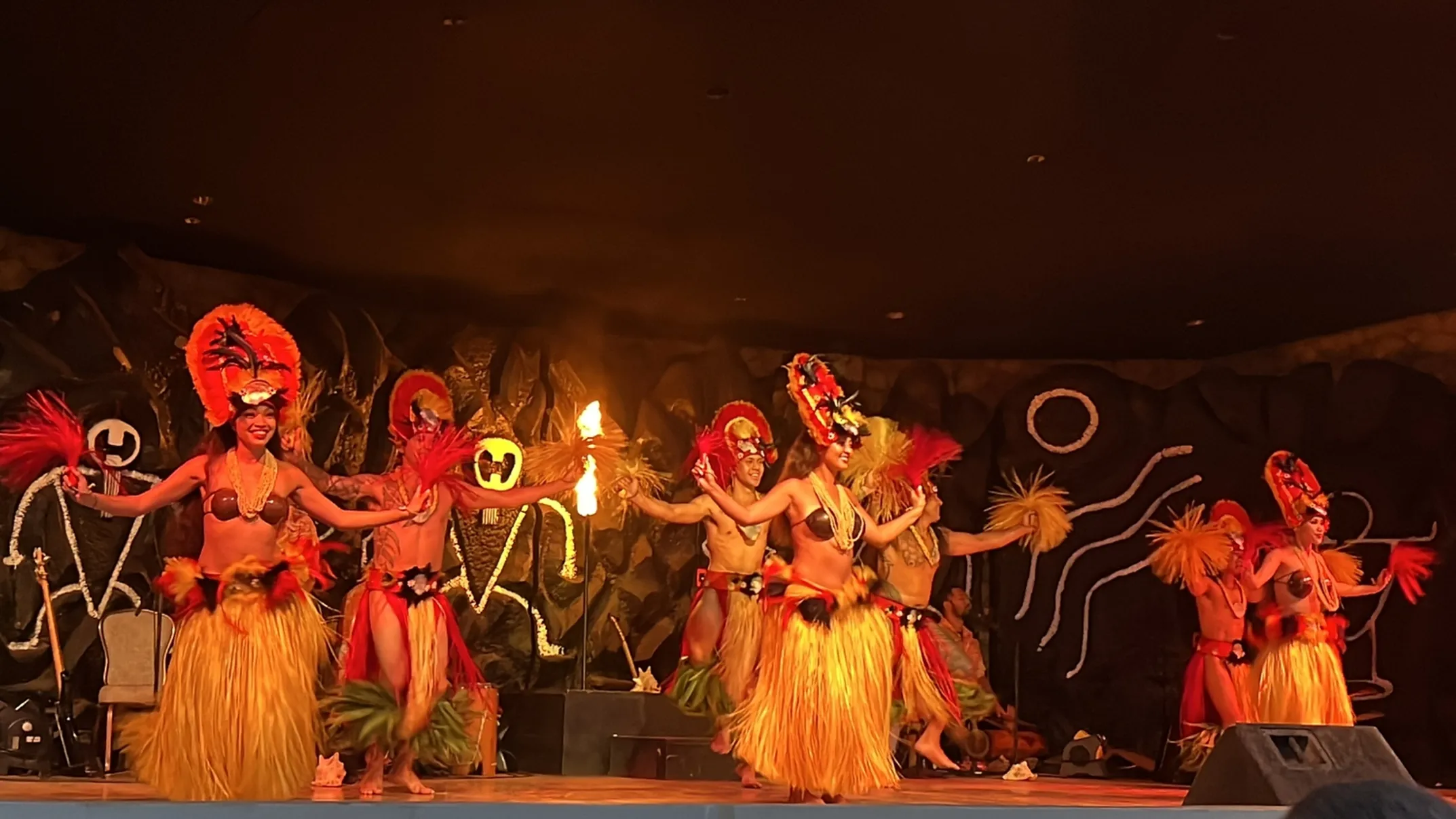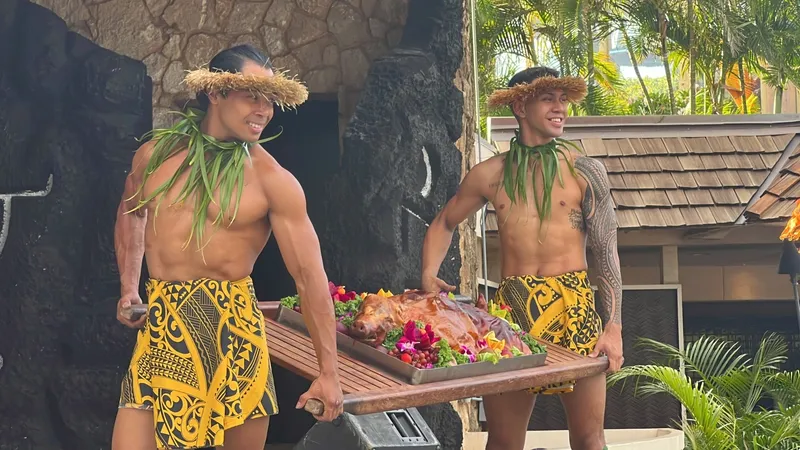
Ali’i Premium Package: Midsection Seating
Mauka Warriors Luau • Cultural Performance • Kapolei • Oahu

Core elements of an authentic Hawaiian Lūʻau

Written by a Local Cultural Expert
Kalani MillerThe imu ceremony always gives me chicken skin - that's what we call goosebumps here. Watching the layers of ti leaves and burlap get peeled back. Seeing steam rise from the pit. Smelling that deep, earthy aroma that means home.
Building an imu takes skill passed down through families. First, you dig the pit. Size depends on how many mouths you're feeding. My uncle always says, "Dig with your heart, not just your hands."
This process connects us to our ancestors. Before electric ovens, before gas grills, this was how families fed their communities.
Next comes the fire. Dense hardwood like ironwood burns hottest and longest. We pile volcanic rocks on top. These aren't random stones. River rocks work best because they hold heat without exploding. After hours of burning, the wood becomes embers. The rocks glow like small suns.
Then the real art begins. Remove every piece of wood and charcoal. Lay down banana stumps, pounded to release moisture. Add layers of banana leaves or ti leaves. Place the whole pig on this green bed, seasoned simply with Hawaiian sea salt. Sometimes hot stones go inside the pig's cavity for even cooking.
More leaves cover everything. Wet burlap seals in the steam. Finally, dirt or tarps trap every bit of heat. The pig cooks slowly for eight to ten hours, becoming so tender it falls apart at touch.
The imu represents patience, planning, the willingness to work together for something bigger than yourself. Not every modern lūʻau can dig a full imu. Logistics get complicated. But the best ones explain the process. They help you understand this isn't just cooking. It's a ceremony.
Dense hardwood burns with volcanic rocks on top. The fire must burn for hours until rocks glow like small suns.
Banana stumps and ti leaves create a natural steam chamber. This green bed protects and flavors the pork.
Seasoned with Hawaiian sea salt, the pig cooks slowly in its own juices, becoming incredibly tender.
The ceremony of unveiling creates that magical moment when earth gives up its perfectly cooked treasure.
Learn about traditional cooking methods and cultural preservation.
Walking up to a lūʻau buffet can feel overwhelming if you don't know the stories behind the dishes. Each food carries history. Some arrived with the first Polynesian voyagers over a thousand years ago. Others came with plantation workers, missionaries, modern immigrants. Together, they tell the story of Hawaiʻi.

Sits at the center of everything. Made from steamed, pounded taro root mixed with water. Its texture ranges from thick (one-finger poi) to thin (three-finger poi). For us, it's comfort. Poi bowls were sacred. Sharing poi made you family, even if you weren't related by blood.
Emerges from that imu pit perfectly tender and smoky. No fancy marinades. Just pork, salt, and time. The slow steam cooking locks in moisture while adding that distinctive earthy flavor you can't get from any other cooking method.
Wraps pork or chicken in young taro leaves, then ti leaves, and steams alongside the pig. The taro leaves cook down like spinach but with a unique flavor that complements the meat. Opening a laulau feels like unwrapping a present.
Came with those first voyaging canoes. These "canoe crops" kept families alive during long ocean crossings and provided starch for growing communities. Purple Molokaʻi sweet potatoes taste like candy straight from the earth.
Shows how cultures blend. Salted salmon came with 19th-century traders. Our people mixed it with tomatoes and onions, creating something completely new. "Lomi lomi" means "to massage" - you break up the salmon with your hands.
Started as simple raw fish with salt, seaweed, and crushed kukui nuts. Japanese immigrants added soy sauce and sesame oil. Korean immigrants brought chili pepper. Now poke represents Hawaiʻi's multicultural evolution.
Arrived with Chinese plantation workers. Cellophane noodles, chicken, ginger, green onions simmered into comfort soup. It's not traditionally Hawaiian, but it's become traditionally local.
Might seem random, but it's essential to any local plate lunch or lūʻau spread. Creamy, simple, it balances the saltiness of other dishes.
Provides cool, sweet relief after spicy or salty foods. This coconut pudding tastes like the islands - simple, pure, refreshing. The perfect ending to any lūʻau meal.
Each dish connects to someone's story. Someone's journey to these islands. Someone's way of making a new place feel like home.
When hula begins, the air changes. You feel it before you see it. The drums set your heartbeat. The dancers step into stories older than memory.
People think hula is just pretty dancing. They're wrong. Hula is our library. Our history book. Our prayer book. For centuries before writing existed here, hula preserved our genealogies, our legends, our connection to the divine.
Traditional hula feels powerful, sometimes fierce. Dancers wear simple kapa cloth or ti leaves. Men and women both dance - hula was never just for women. The movements tell specific stories. A gentle sway might represent trade winds. Sharp hand gestures could show spears in battle.
Between 1830 and the 1870s, missionaries convinced Queen Kaʻahumanu to ban public hula. They called it immoral and pagan. But our people kept dancing in secret. In remote valleys, away from disapproving eyes. This underground preservation saved hula from extinction.
King David Kalākaua changed everything when he took the throne in 1874. He officially brought hula back, saying "Hula is the language of the heart, and therefore the heartbeat of the Hawaiian people." That revival spirit continues today.
Modern hula flows like water. Dancers wear flowing dresses or cellophane skirts. ʻUkuleles and guitars provide melody. Steel guitars add that distinctly Hawaiian sound that makes you think of sunset beaches.
These dances tell different stories. Love songs, descriptions of beautiful places, personal experiences. The movements stay graceful, telling tales through gesture and expression.
Both styles matter. Kahiko connects us to our ancestors. ʻAuana shows how our culture lives and breathes and grows.
Behind every hula lies mele - chant or song. These aren't random lyrics. They're carefully crafted poetry that carries meaning in every syllable.
Traditional mele oli (chants) honor gods, ancestors, natural forces. They sound like the ocean, like wind through valleys, like rain on leaves. Modern mele might tell family stories or describe the way morning light hits Diamond Head.
The language itself adds layers of meaning. Hawaiian words often have multiple interpretations. One mele might describe a physical landscape while symbolically talking about the human body or emotional state. Master chanters spent years learning these subtleties.
Our music blends ancient and introduced instruments into something uniquely Hawaiian.
Traditional percussion sets the foundation. Gourds become drums. Bamboo splits into rhythm sticks. Even simple stones create music when struck together skillfully.
Introduced instruments found new voices here. Portuguese immigrants brought the cavaquinho, which became our beloved ʻukulele. Guitars were retuned into slack-key style, creating those cascading, open sounds that define Hawaiian music. Steel guitars played with metal bars produce that crying, beautiful tone you hear in classic island songs.
The fire knife dance always comes last. It has to. After that explosive finale, anything else would feel like an anticlimax. This isn't Hawaiian tradition - it's Samoan. But Polynesian cultures share deep connections. We're family spread across the Pacific.
Ancient Samoan warriors performed similar dances with wooden clubs edged with shark teeth or boar tusks. These weren't entertainment. They were displays of skill, strength, readiness for battle. Adding fire came later, in 1946, when a Samoan dancer named Freddie Letuli wrapped his knife with fuel-soaked towels and lit them.
Modern fire knife dancers are athletes and artists. They spin multiple flaming blades, throw them high, catch them behind their backs. The danger is real. The skill required is extraordinary. Including Siva Afi at Hawaiian lūʻau honors our Polynesian connections.
Your lūʻau experience begins before you reach your seat. Someone places a lei around your shoulders, and suddenly you're wearing aloha.
Lei represent far more than decoration. They embody love, respect, welcome, honor. When someone gives you a lei, they're offering their spirit. Refusing would be like rejecting their heart.
Different leis carry different meanings. Fresh flower leis - orchids, plumeria, tuberose - smell like paradise and feel special against your skin. Kukui nut leis connect you to the tree that provided light and oil for our ancestors. Shell leis link you to the ocean that surrounds and sustains us.
Wear your lei properly. Drape it over both shoulders so it hangs evenly front and back. Don't remove it in front of the giver - that shows disrespect. When the evening ends, return your lei to nature. Hang it on a tree, scatter the flowers in your garden, let it decompose and feed new growth.
This simple exchange sets the tone for everything that follows. You're not just a customer buying dinner and a show. You're a welcomed guest sharing in our traditions.
Each instrument serves the story. Supports the dance. Carries the culture forward.

Mauka Warriors Luau • Cultural Performance • Kapolei • Oahu

Mauka Warriors Luau • Cultural Performance • Kapolei • Oahu

Mauka Warriors Luau • Cultural Performance • Kapolei • Oahu